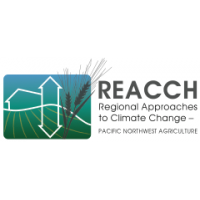As funding agencies embrace open science principles that encourage sharing data and computer code developed to produce research outputs, we must respond with new modes of publication. Furthermore, as we address the expanding reproducibility crisis in the sciences, we must work to release research materials in ways that enable reproducibility—publishing data, computer code, and research products in addition to the traditional journal article. Toward addressing these needs, we present an example framework to model and map soil organic carbon (SOC) in the cereal grains production region of the northwestern United States. Primarily associated with soil organic matter, SOC relates to many soil properties that influence resiliency and soil health for agriculture. It is also critical for understanding soil-atmospheric carbon flux, a significant part of the overall carbon budget of the Earth. The scorpan technique for modeling soil properties uses seven categories of environmental input data to make predictions: known soil attributes, climatic values, organisms present, relief, parent material, age, and spatial location. We gather data representing these categories from various public sources. The map is produced using a random forest statistical model with scorpan inputs to predict SOC content on a 30 m spatial grid. All modeling components including input data, metadata, computer code, and output products are made freely available under an explicit open source license. In this way, reproducibility is supported; the methods and code released are available to be re-used by other researchers; and the research products are open to critical review and improvement.
Data and Resources
- Data for Building an Open Science Framework to Model Soil Organic Carbon (data)zip
Data development process Software and algorithms The methods listed in this...
Go to resource
| Field | Value |
|---|---|
| Modified | 2022-03-16 |
| Release Date | 2018-03-07 |
| Publisher | |
| Identifier | eee34445-11c2-4e2c-a76f-219c26b537ec |
| Spatial / Geographical Coverage Area | POLYGON ((-121.83837890625 43.948536571678, -121.83837890625 49.055150393383, -115.51025390625 49.055150393383, -115.51025390625 43.948536571678)) |
| Spatial / Geographical Coverage Location | Idaho, Oregon, Washington, USA |
| Temporal Coverage | Monday, January 1, 1923 - 00:00 to Saturday, December 31, 2016 - 00:00 |
| Language | English (United States) |
| License | |
| Granularity | 30 meter |
| Author | |
| Contact Name | Edward Flathers |
| Contact Email | |
| Public Access Level | Public |
| DOI | 10.7923/G4XP72ZB |


![[Open Data]](https://assets.okfn.org/images/ok_buttons/od_80x15_blue.png)